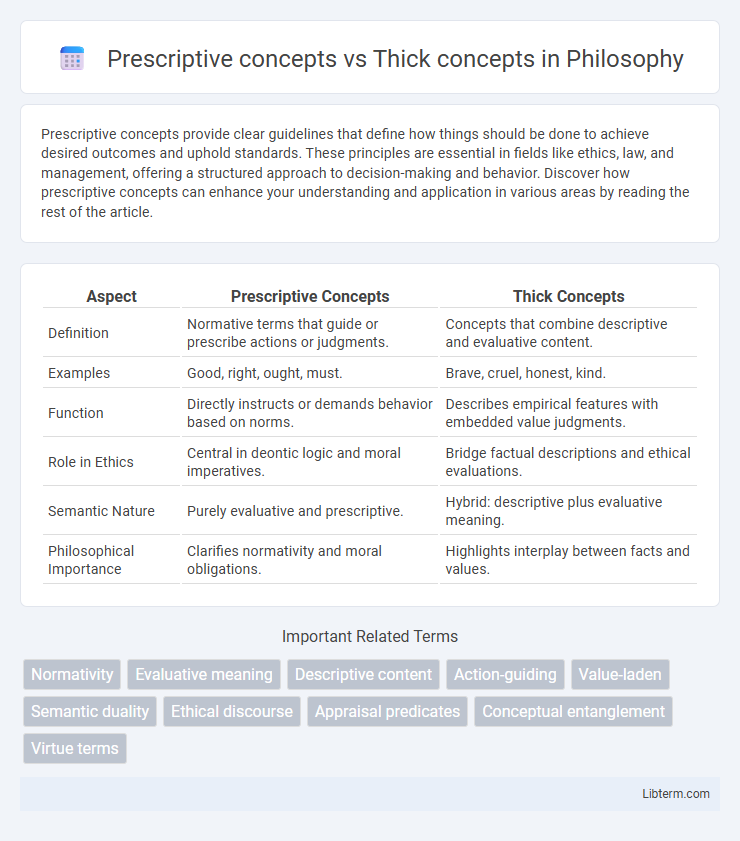Prescriptive concepts provide clear guidelines that define how things should be done to achieve desired outcomes and uphold standards. These principles are essential in fields like ethics, law, and management, offering a structured approach to decision-making and behavior. Discover how prescriptive concepts can enhance your understanding and application in various areas by reading the rest of the article.
Table of Comparison
| Aspect | Prescriptive Concepts | Thick Concepts |
|---|---|---|
| Definition | Normative terms that guide or prescribe actions or judgments. | Concepts that combine descriptive and evaluative content. |
| Examples | Good, right, ought, must. | Brave, cruel, honest, kind. |
| Function | Directly instructs or demands behavior based on norms. | Describes empirical features with embedded value judgments. |
| Role in Ethics | Central in deontic logic and moral imperatives. | Bridge factual descriptions and ethical evaluations. |
| Semantic Nature | Purely evaluative and prescriptive. | Hybrid: descriptive plus evaluative meaning. |
| Philosophical Importance | Clarifies normativity and moral obligations. | Highlights interplay between facts and values. |
Understanding Prescriptive Concepts
Prescriptive concepts guide behavior by expressing norms, values, and obligations, shaping moral and social decision-making. They differ from thick concepts, which combine descriptive and evaluative elements but lack explicit directive force. Understanding prescriptive concepts is crucial for interpreting ethical language and frameworks that regulate actions within societies.
Defining Thick Concepts
Thick concepts combine descriptive and evaluative elements, providing both factual information and moral or normative significance within their meaning. Defining thick concepts involves identifying terms like "courage," "cruelty," or "justice," which express complex qualities that are not purely objective or purely subjective. These concepts play a crucial role in ethical discussions by linking language to value-laden judgments and cultural interpretations.
Key Differences Between Prescriptive and Thick Concepts
Prescriptive concepts express normative judgments and guide actions by indicating what ought to be done or valued, such as "justice" or "courage," emphasizing ethical or evaluative standards. Thick concepts combine descriptive and evaluative content, providing both factual information and normative assessment simultaneously, exemplified by terms like "cruel" or "generous." The key difference lies in prescriptive concepts primarily focusing on norms and guidance for behavior, whereas thick concepts intertwine objective descriptions with moral evaluations.
Historical Development of Conceptual Distinctions
The historical development of prescriptive and thick concepts traces back to early analytic philosophy where prescriptive concepts, such as "ought," were distinguished by their normativity and action-guiding roles. Thick concepts, exemplified by terms like "courage," integrate descriptive and evaluative elements, reflecting complex social practices and cultural norms in their evolution. Philosophers like Elizabeth Anscombe and G.E. Moore advanced this distinction, emphasizing how thick concepts convey both empirical content and ethical significance, marking a pivotal shift in moral philosophy and linguistic analysis.
Roles in Ethics and Moral Philosophy
Prescriptive concepts play a crucial role in ethics by guiding appropriate behavior through explicit norms and standards, influencing decision-making processes and moral judgments. Thick concepts combine descriptive and evaluative content, offering rich characterizations that shape ethical understanding by linking factual states with moral significance. Both concepts are central to moral philosophy, as prescriptive concepts provide normative directives while thick concepts deepen comprehension of ethical phenomena by embedding value within descriptions.
Influence on Language and Communication
Prescriptive concepts impose rules and standards that shape language use by dictating what is considered correct or acceptable, influencing communication through norm enforcement and clarity. Thick concepts combine descriptive and evaluative aspects, embedding moral or cultural judgments within language, thus affecting interpretation and nuanced understanding in discourse. The interplay between these concepts guides how speakers convey intentions and negotiate meaning in social interactions.
Examples of Prescriptive Concepts in Practice
Prescriptive concepts, such as honesty, justice, and kindness, serve as ethical standards guiding behavior and decision-making in diverse fields like law, medicine, and education. For instance, the principle of justice mandates fairness in legal systems by ensuring equal treatment regardless of background, while honesty underpins medical ethics through transparent patient communication. These concepts drive normative judgments that shape societal expectations and professional conduct.
Examples of Thick Concepts in Real Life
Justice, honesty, and courage serve as prime examples of thick concepts because they combine descriptive content with evaluative judgments, reflecting both factual and moral dimensions. In real life, these concepts are used to assess actions and character, such as praising courage during heroic acts or condemning dishonesty in business practices. Thick concepts guide ethical behavior by embedding values within everyday language, influencing social norms and personal decisions.
Challenges in Applying These Concepts
Applying prescriptive concepts involves challenges such as subjective interpretation and contextual variability, which complicate creating universal guidelines for behavior. Thick concepts combine descriptive and evaluative elements, making it difficult to separate objective facts from moral judgments in practice. This entanglement often leads to disputes over meaning and application in ethical and philosophical discussions.
Implications for Contemporary Debates
Prescriptive concepts, which involve normative judgments about what ought to be done, contrast with thick concepts that combine descriptive and evaluative content, shaping how moral and social issues are understood. This distinction influences contemporary debates by clarifying whether disagreements arise from factual misunderstandings or value-based conflicts, impacting discourse in ethics, law, and political philosophy. Recognizing the interplay between prescriptive and thick concepts aids in resolving disputes by identifying the root causes of disagreement and refining argumentation strategies.
Prescriptive concepts Infographic

 libterm.com
libterm.com